Sam Judge is a painter working from his studio in Middlesbrough. He takes a process-driven approach to his abstract paintings, creating without preconceived ideas and allowing the work to evolve over successive layers of gestural marks that document his energetic approach.

Sam Judge in the studio.
Court: Hey, thanks for having me over! This is my first time to Middlesbrough and this place is awesome. My first question has to be, is this a real train station?
Sam: Yes, you step off the train and straight into Platform A Gallery. The studios are connected to the back of the Gallery, tucked away from the public.
Court: That’s so cool, and what a good commute for anyone coming via train! I’m loving the Gallery and heated studio spaces! How long have you had your studio for? And what prompted the move?
Sam: I moved in at the start of the summer. I was painting in a spare room in my house, which I was sharing with my wife who was building her pottery practice. I was itching to paint at a larger scale and slowly realising dust and wet oil paintings are not the best of friends, so it was time for me to find somewhere else.
Court: So you guys moved from London a few years ago. I know being closer to your in-laws played a part so they could see (and help with) your son. And how are you finding Middlesbrough?
Sam: My son’s five now and we moved up when he was getting to a point where he could no longer be contained in his buggy when moving about central London. He’s very active and independent so we found ourselves getting out of the city most weekends and eventually wondering why we continued to live there. Middlesbrough has been a great place to begin my art practice. There’s an incredibly supportive scene of artists, curators and gallerists in various stages of their careers and a real DIY attitude to putting on shows and events.
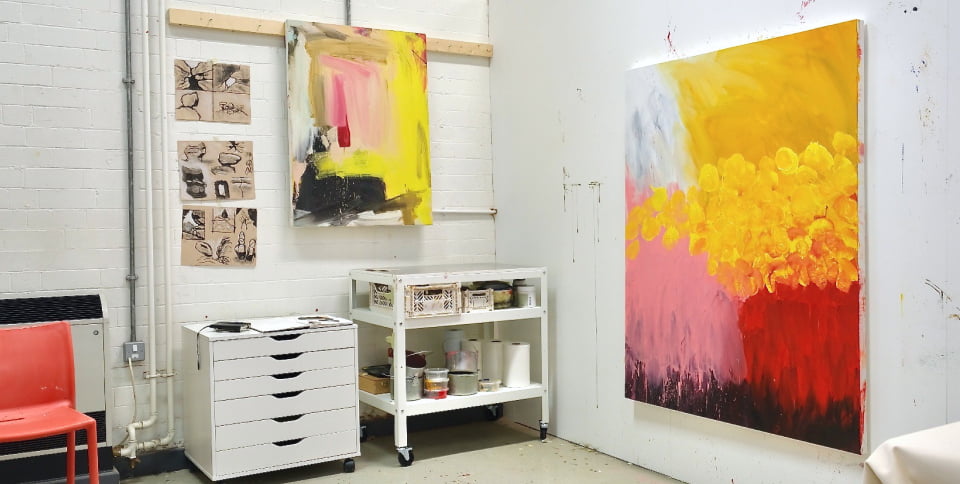
Work in progress in the studio.
Court: I think that DIY culture gives you the confidence to make things happen without waiting for permission or someone else to invite you! When did you start painting? And what inspires your work?
Sam: I had wanted to paint for years. Over the last 10 years I had a number of failed attempts to get going but never really stuck with it. I kept telling myself that I needed to wait until I could afford to not work. Then I saw a meme online that read “What do most artists have in common? …a second job”. It sounds so obvious now but back then I didn’t know anyone who was an artist, so I genuinely thought they were either already rich or were making money through sales of their work. Since realising that very few artists are actually able to work at it full-time, I figured if I wanted to do it that badly I either need to make it a priority or stop thinking about it.
I’m inspired by the unexpected. I want to be as surprised by how my paintings turn out as the person looking at them. I work without any prior conception and try to go where the painting takes me. There are of course some decisions I need to make, such as colour. I’d say nature inspires those, in particular the sky. One thing I noticed about moving up north was how much more varied the sky can be. Living on the edge of the North Yorkshire Moors it can be grey one minute and full of colour the next.
Court: I love that you’ve not taken the “traditional” path into the arts. I think that gives you a different and possibly more rounded perspective. Is your route into art something you ever consider? How do you feel about your entry into the arts?
Sam: When I was 18 I wasn’t ready to study art. I barely knew who I was. I had been fed a narrative that university should be directly linked to a career path. I didn’t know what that path for me was, so I decided to work a few jobs whilst I figured it out. The benefit of that is that 12 years on I have a career in digital design that can financially support my art practice.
If I could take myself back in time with the maturity I have today I feel I’d get a lot out of the traditional path. All is not lost though, this year I’ve enrolled on the Turps Correspondence course. I’m paired with a mentor and get valuable advice and critique on my work with the benefit of continuing to do it remotely from my studio.
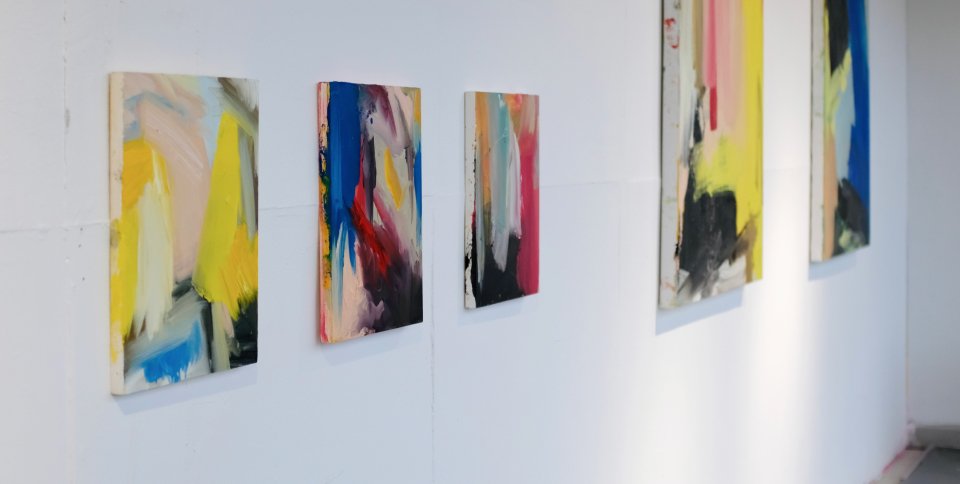
Nothing New exhibition at Pineapple Black.
Court: Ah that’s brilliant and so important to have a mentor and a support network. In talking to artists who are parents, it sounds like you have to be much more focused and productive in the small windows of time you have available to make and create. How has becoming a parent changed your approach to creating work?
Sam: After becoming a dad I really felt the reality that time was no longer just mine. As a result, I felt the need to work on everything I thought about doing but had never done. This led to a lot of frustration in the early days when both money and time were scarce. But I’ve recently found a little more balance. Knowing I’ve got to get back for the school run or to make dinner means I make the most of the time I have in the studio and I’m very work-like in my approach to it. I think a lot of people assume that painting is a peaceful and self-indulgent process. If that were the case I’d feel too guilty to take the time.

Studio desk.
Court: In 2019 you self-published Disquiet: The Hidden Depths of Men, exploring modern masculinities. It’s an absolutely beautiful publication, the way it is written, designed and the entire ethos behind it. Can you tell us how that project came about, your approach and where it’s available? And are there plans for this to become a series?
Sam: I wanted a creative outlet that I was no longer getting from my design career. It had been years since I worked with print and typography, and I was itching to get back to the simplicity of that. I looked around for inspiration and was specifically looking for great magazines. In doing so I felt dismayed by the state of mens magazines. It struck me that they were all pushing a consumer-driven narrative and were very prescriptive about how men should be. The men I knew were nothing like that. So I wanted the content to be free from any specific agenda and simply give the space for a group of unknown “average men” to speak their mind, share their story, and just be. This ethos helped steer creative decisions. For instance, there are no staged photoshoots of the individuals.
I have a loose plan for a follow-up issue but, ironically for a zine exploring mental health, the project was so all-consuming that I’m waiting until I’ve got enough energy to make a start on it. You can buy copies of Disquiet from my site [linked here].
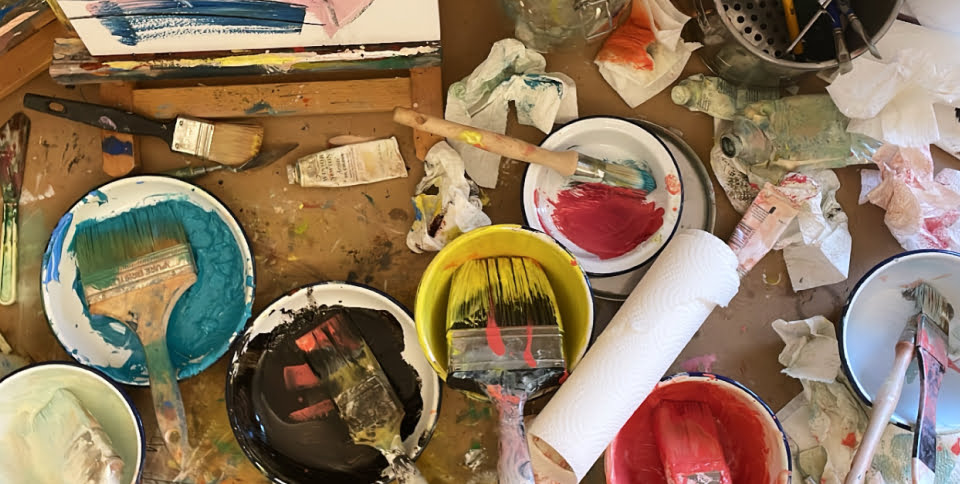
Materials in the studio.
Court: That’s brill, and really is worth a read! So, moving onto career highlights. What are your career highlights to date?
Sam: It might sound a little twee but so far my highlight was moving into my studio. I had dreamed about having my own white room for so long. I feel incredibly lucky to have the space I’ve got.
Court: I think that’s so nice to take a moment to be grateful for that space and what it represents. A studio be it at home, in your shed or elsewhere is so important. I think that is a great highlight. You have work in The Mercer Open in Harrogate until 8 Jan 2023. Do you have any other exhibitions coming up? And what’s the best way for people to keep updated with what you’re doing?
Sam: The best way to see what I’m up to is Instagram. Right now I’m working on a new series of large-scale works but no plans for showing them as yet.
Court: Brill! Well I’ll be sure to keep tabs on that and I really look forward to seeing the series of larger canvases. Thank you so much, this has been brilliant and such a joy to get to chat properly and see more of your work.
Filed under: Art & Photography
Tagged with: colour, fatherhood, London, masculinity, Middlesbrough, Nature, paint, painting, self-publishes, Studio, the north, yorkshire
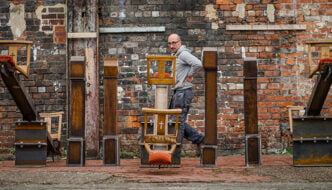
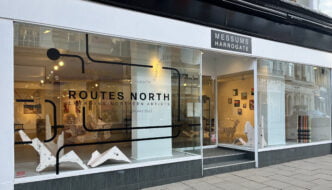
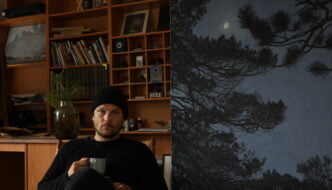
Comments